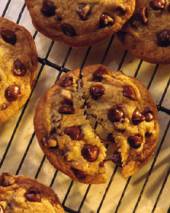Diana's Desserts - www.dianasdesserts.com
http://www.dianasdesserts.com/index.cfm/fuseaction/recipes.recipeListing/filter/dianas/recipeID/2199/Recipe.cfm
Chewy and Thick Chocolate Chip Cookies
 Servings: Makes 1 1/2 dozen (3-inch) cookies
Servings: Makes 1 1/2 dozen (3-inch) cookies
Comments:
From Cook's Illustrated:
Solving the Mystery of the Chewy Chocolate Chip Cookie:
After testing forty different variations, we discover how to make a thick, chewy gourmet shop cookie at home.
The Challenge:
The quest began simply enough: we wanted to duplicate, at home, the big, delicious, chewy chocolate chip cookies bought in the trendy specialty cookie shops. For us, first and foremost, this new genre of home-baked chocolate chip drop cookie had to look and taste like the ultimate, sinful cookie: thick (about one-half inch high), jumbo (three inches in diameter), and bursting with chocolate. It also had to have a mouthwatering, uneven surface texture with rounded edges, be slightly crispy but tender on the outside, and rich, buttery, soft, and chewy inside.
The Solution:
We found one key element to achieving this cookie was melting the butter. According to food scientist Shirley Corriher, when butter is melted, free water and fat are separated from each other. When this melted butter is combined with flour, the proteins in the flour grab the water and each other to immediately form elastic sheets of gluten. This creates a product with a chewy texture. At the same time, the sugars and fats are working to inhibit gluten formation, which prevents the cookies from getting too tough. After numerous tests, varying the types of flours, proportions of flour to butter, and sifting and not sifting, we decided that the best cookie resulted from unsifted, bleached, all-purpose flour, which has a lower protein content than unbleached. Also, the problem of the cookie hardening after several hours was eliminated by the addition of a single egg yolk, because the added fat acts as a tenderizer.
For Good Measure:
All ovens are different, so be vigilant and remove the cookies from the oven promptly when they are done. Even the method of cooling turns out to be an important step in maintaining the chewy texture of this cookie. To maintain their soft, chewy texture, leave the cookies on the cookie sheet until cooled.
Note:
These truly chewy chocolate chip cookies are delicious served warm from the oven or cooled. To ensure a chewy texture, leave the cookies on the cookie sheet to cool. You can substitute white, milk chocolate, or peanut butter chips for the semisweet or bittersweet chips called for in the recipe. In addition to chips, you can flavor the dough with one cup of nuts, raisins, or shredded coconut.
Ingredients:
2 1/8 cups (2 cups plus 2 tablespoons) unsifted bleached all-purpose flour
1/2 teaspoon salt
1/2 teaspoon baking soda
12 tablespoons unsalted butter (1 1/2 sticks/3/4 cup/6 oz/170 g), melted and cooled until warm
1 cup light or dark brown sugar, tightly packed
1/2 cup granulated sugar
1 large egg plus 1 egg yolk
2 teaspoons vanilla extract
1–2 cups semisweet or bittersweet chocolate chips or chocolate chunks
Instructions:
1. Preheat oven to 325 degrees F (160 degrees C). Adjust oven racks to upper- and lower-middle positions.
2. Mix flour, salt, and baking soda together in medium bowl; set aside.
3. Either by hand or with electric mixer, mix butter and sugars until thoroughly blended. Mix in egg, yolk, and vanilla. Add dry ingredients; mix until just combined. Stir in chips (or chocolate chunks, if using) to taste.
4. Form scant 1/4 cup dough into ball. Holding dough ball using fingertips of both hands, pull into two equal halves. Rotate halves ninety degrees and, with jagged surfaces exposed, join halves together at their base, again forming a single cookie, being careful not to smooth dough’s uneven surface. Place formed dough onto one of two parchment paper-lined 20-by-14-inch lipless cookie sheets, about nine dough balls per sheet. Smaller cookie sheets can be used, but fewer cookies can be baked at one time and baking time may need to be adjusted. (Dough can be refrigerated up to 2 days or frozen up to 1 month—shaped or not.
5. Bake, reversing cookie sheets’ positions halfway through baking, until cookies are light golden brown and outer edges start to harden yet centers are still soft and puffy, 15 to 18 minutes (start checking at 13 minutes). (Frozen dough requires an extra 1 to 2 minutes baking time.) Cool cookies on cookie sheets. Serve or store in airtight container.
Makes 1 1/2 dozen 3-inch cookies.
Source: Cook's Illustrated
Date: June 4, 2004
 Servings: Makes 1 1/2 dozen (3-inch) cookies
Servings: Makes 1 1/2 dozen (3-inch) cookies